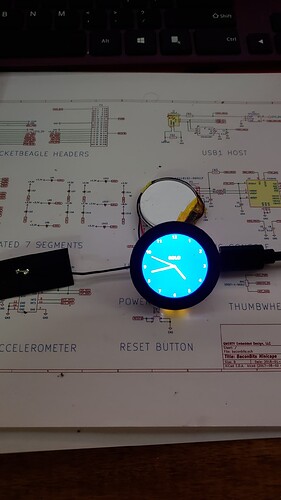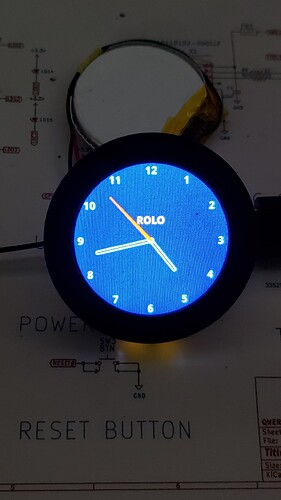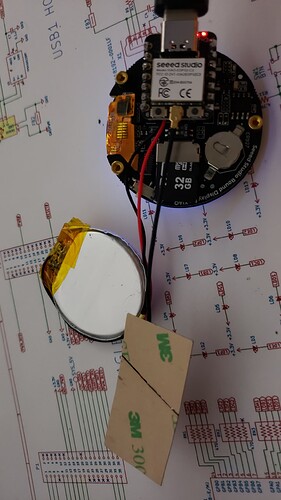So, i went and Grabbed a Xiao Esp32C3 took some uninstall of tbe TFT_Espi in the brds file ,and include Zip lib of the git hub one.
Works ok. with “TFT_eSPIClock.ino” example
But time is off , by some hours, the RTC and NTP server time are correct.
Go figure.![]()
![]()
Here is whats working.
#include <Arduino.h>
#include <TFT_eSPI.h>
#include <SPI.h>
#include <Wire.h>
#include "time.h" //
#include "RTClib.h" //
#if defined(CONFIG_IDF_TARGET_ESP32S3) || defined(CONFIG_IDF_TARGET_ESP32C3)
#include "esp_wifi.h"
#include "WiFi.h"
#include "esp_wps.h" //
const char *ntpServer = "time.cloudflare.com";
const char *ssid = "GlassSurf-2.4";
const char *password = "SEEDSTUDIO :-p "; // edited for security and LOL's
#endif
#include "I2C_BM8563.h"
#include "NotoSansBold15.h"
#define ESP_MANUFACTURER "SEEED"
#define ESP_MODEL_NUMBER "ESP32C3"
#define ESP_MODEL_NAME "Xiao ESP"
I2C_BM8563 rtc(I2C_BM8563_DEFAULT_ADDRESS, Wire);
I2C_BM8563_TimeTypeDef timeStruct;
I2C_BM8563_DateTypeDef dateStruct;
//I2C_BM8563_TimeTypeDef tStruct;
TFT_eSPI tft = TFT_eSPI(); // Invoke library, pins defined in User_Setup.h
TFT_eSprite face = TFT_eSprite(&tft);
uint32_t chipId = 0;
#define CLOCK_X_POS 10
#define CLOCK_Y_POS 10
#define CLOCK_FG TFT_SKYBLUE
#define CLOCK_BG TFT_NAVY
#define SECCOND_FG TFT_RED
#define LABEL_FG TFT_GOLD
#define CLOCK_R 230.0f / 2.0f // Clock face radius (float type)
#define H_HAND_LENGTH CLOCK_R/2.0f
#define M_HAND_LENGTH CLOCK_R/1.4f
#define S_HAND_LENGTH CLOCK_R/1.3f
#define FACE_W CLOCK_R * 2 + 1
#define FACE_H CLOCK_R * 2 + 1
// Calculate 1 second increment angles. Hours and minute hand angles
// change every second so we see smooth sub-pixel movement
#define SECOND_ANGLE 360.0 / 60.0
#define MINUTE_ANGLE SECOND_ANGLE / 60.0
#define HOUR_ANGLE MINUTE_ANGLE / 12.0
// Sprite width and height
#define FACE_W CLOCK_R * 2 + 1
#define FACE_H CLOCK_R * 2 + 1
const long gmtOffset_sec = -18000; //For UTC -5.00 : -5 * 60 * 60 : -18000
const int daylightOffset_sec = 3600;
// Time h:m:s
uint8_t h = 0, m = 0, s = 0;
float time_secs = h * 3600 + m * 60 + s;
// Time for next tick
uint32_t targetTime = 0;
// =========================================================================
// Setup
// =========================================================================
void setup() {
Serial.begin(9600);
delay(2500); //relax...Get Ready for serial port
Serial.println();
Serial.println();
Serial.println("Power ON "); // Let's BEGIN!!
Serial.println("");
// Init and get the time
// configTime(gmtOffset_sec, daylightOffset_sec, ntpServer);
//printLocalTime();
Serial.println("Program " __FILE__ " compiled on " __DATE__ " at " __TIME__ );
Serial.println();
// Initialise the screen
tft.init();
// Ideally set orientation for good viewing angle range because
// the anti-aliasing effectiveness varies with screen viewing angle
// Usually this is when screen ribbon connector is at the bottom
tft.setRotation(0);
tft.fillScreen(TFT_BLACK);
// Create the clock face sprite
//face.setColorDepth(8); // 8 bit will work, but reduces effectiveness of anti-aliasing
face.createSprite(FACE_W, FACE_H);
// Only 1 font used in the sprite, so can remain loaded
face.loadFont(NotoSansBold15);
// Draw the whole clock - NTP time not available yet
renderFace(time_secs);
#if defined(CONFIG_IDF_TARGET_ESP32S3) || defined(CONFIG_IDF_TARGET_ESP32C3)
WiFi.begin(ssid, password);
while ( WiFi.status() != WL_CONNECTED )
{
delay ( 500 );
Serial.print ( "." );
}
Serial.println("");
// Init and get the time
//configTime(gmtOffset_sec, daylightOffset_sec, ntpServer);
configTime(8 * 3600, 0, ntpServer);
struct tm timeInfo;
if (getLocalTime(&timeInfo)) {
timeStruct.hours = timeInfo.tm_hour;
timeStruct.minutes = timeInfo.tm_min;
timeStruct.seconds = timeInfo.tm_sec;
rtc.setTime(&timeStruct);
//dateStruct.weekDay = timeInfo.tm_wday;
//dateStruct.month = timeInfo.tm_mon + 1;
//dateStruct.date = timeInfo.tm_mday;
//dateStruct.year = timeInfo.tm_year + 1900;
//rtc.setDate(&dateStruct);
}
#endif
Wire.begin();
rtc.begin();
syncTime();
Serial.println();
for(int i=0; i<17; i=i+8) {
chipId |= ((ESP.getEfuseMac() >> (40 - i)) & 0xff) << i;
}
Serial.printf("ESP32 Chip model = %s Rev %d\n", ESP.getChipModel(), ESP.getChipRevision());
Serial.printf("This chip has %d cores\n", ESP.getChipCores());
Serial.print("Chip ID: "); Serial.println(chipId);
Serial.println("Connected to :" + String(WiFi.SSID()));
Serial.print("Got IP: ");
Serial.println(WiFi.localIP());
delay (500);
printLocalTime();
}
// =========================================================================
// Loop
// =========================================================================
void loop() {
// Update time periodically
if (targetTime < millis()) {
// Update next tick time in 100 milliseconds for smooth movement
targetTime = millis() + 100;
// Increment time by 100 milliseconds
time_secs += 0.100;
// Midnight roll-over
if (time_secs >= (60 * 60 * 24)) time_secs = 0;
// All graphics are drawn in sprite to stop flicker
renderFace(time_secs);
// syncTime();
}
}
// =========================================================================
// Draw the clock face in the sprite
// =========================================================================
static void renderFace(float t) {
float h_angle = t * HOUR_ANGLE;
float m_angle = t * MINUTE_ANGLE;
float s_angle = t * SECOND_ANGLE;
// The face is completely redrawn - this can be done quickly
face.fillSprite(TFT_BLACK);
// Draw the face circle
face.fillSmoothCircle( CLOCK_R, CLOCK_R, CLOCK_R, CLOCK_BG );
// Set text datum to middle centre and the colour
face.setTextDatum(MC_DATUM);
// The background colour will be read during the character rendering
face.setTextColor(CLOCK_FG, CLOCK_BG);
// Text offset adjustment
constexpr uint32_t dialOffset = CLOCK_R - 10;//10
float xp = 0.0, yp = 0.0; // Use float pixel position for smooth AA motion
// Draw digits around clock perimeter
for (uint32_t h = 1; h <= 12; h++) {
getCoord(CLOCK_R, CLOCK_R, &xp, &yp, dialOffset, h * 360.0 / 12);
face.drawNumber(h, xp, 2 + yp);
}
// Add text (could be digital time...)
face.setTextColor(LABEL_FG, CLOCK_BG);
face.drawString("ROLO", CLOCK_R, CLOCK_R * 0.75);
// Draw minute hand
getCoord(CLOCK_R, CLOCK_R, &xp, &yp, M_HAND_LENGTH, m_angle);
face.drawWideLine(CLOCK_R, CLOCK_R, xp, yp, 6.0f, CLOCK_FG);
face.drawWideLine(CLOCK_R, CLOCK_R, xp, yp, 2.0f, CLOCK_BG);
// Draw hour hand
getCoord(CLOCK_R, CLOCK_R, &xp, &yp, H_HAND_LENGTH, h_angle);
face.drawWideLine(CLOCK_R, CLOCK_R, xp, yp, 6.0f, CLOCK_FG);
face.drawWideLine(CLOCK_R, CLOCK_R, xp, yp, 2.0f, CLOCK_BG);
// Draw the central pivot circle
face.fillSmoothCircle(CLOCK_R, CLOCK_R, 4, CLOCK_FG);
// Draw Second hand
getCoord(CLOCK_R, CLOCK_R, &xp, &yp, S_HAND_LENGTH, s_angle);
face.drawWedgeLine(CLOCK_R, CLOCK_R, xp, yp, 2.5, 1.0, SECCOND_FG);
face.pushSprite(5, 5, TFT_TRANSPARENT);
}
// =========================================================================
// Get coordinates of end of a line, pivot at x,y, length r, angle a
// =========================================================================
// Coordinates are returned to caller via the xp and yp pointers
#define DEG2RAD 0.0174532925
void getCoord(int16_t x, int16_t y, float *xp, float *yp, int16_t r, float a)
{
float sx1 = cos( (a - 90) * DEG2RAD);
float sy1 = sin( (a - 90) * DEG2RAD);
*xp = sx1 * r + x;
*yp = sy1 * r + y;
}
void syncTime(void){
targetTime = millis() + 100;
rtc.getTime(&timeStruct);
time_secs = timeStruct.hours * 3600 + timeStruct.minutes * 60 + timeStruct.seconds;
//rtc.getTime(&tStruct);
// char rtc_time[10];
// sprintf(rtc_time, "%d:%d:%d", tStruct.hours, tStruct.minutes, tStruct.seconds);
//Serial.println(rtc_time);
}
void printLocalTime(){
struct tm timeinfo;
if(!getLocalTime(&timeinfo)){
Serial.println("Failed to obtain time");
return;
}
Serial.println("");
Serial.println(&timeinfo, "%H:%M:%S"); //"%A, %B %d %Y %H:%M:%S"%A returns day of week
/* %B returns month of year
%d returns day of month
%Y returns year
%H returns hour
%M returns minutes
%S returns seconds
*/
}
Hers’s the output
Power ON
Program D:\Arduino_projects\libraries\Seeed_Arduino_Round_display\examples\TFT_eSPI_Clock\TFT_eSPI_Clock.ino compiled on Sep 15 2023 at 20:46:12
..
ESP32 Chip model = ESP32-C3 Rev 3
This chip has 1 cores
Chip ID: 4170632
Connected to :GlassSurf-2.4
Got IP: 192.168.1.188
08:46:31
HTH
GL ![]()


